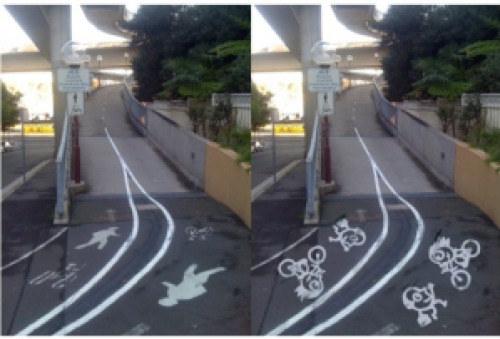To be delighted is to be pleasantly surprised.
How easily we forget the power of delight. It makes people happy and optimistic. It creates salience, so people notice things. It attracts, so people want more. It sparks conversation, so news spreads. And conversation, of course, is the carrier wave of social change. Most social media is powered by the desire to share delight.
Yet, there can hardly be anything as glum and negative as most health, environment, or social justice campaigns. Just take a look at http://osocio.org for a current global selection. Health promotion has been described as “the business of making people live miserably so that they can die healthy”[i] and pretty much the same could be said for most other kinds of social change campaigns.
In a project for the City of Sydney this year we suggested that the city adopt ‘delight’ as a guiding principle for cycle communications. Here’s an example. Imagine if cycle path signs were designed by the ex-Sydney, now totally happening New York cartoonist Jeremy.
I was surprised at how popular the idea was, even with the serious infrastructure bods. Apparently, delight is a fresh idea. Maybe its time has come.
Browsing Osocio, the compendium of social marketing campaigns from around the world, illustrates how rarely delight is used. The preferred techniques are either ponderous attempts to inform or confronting attempts to upset. But here’s a couple of delightful ads I found:
http://osocio.org/message/conflict_fun/
http://osocio.org/message/cycling_for_a_better_libido/
And there’s three more at http://enablingchange.posterous.com/2009/08/grass-is-dumb-and-other-brilliant.html
My new year’s resolution: loosen up and look for ways to use happiness to change the world.
[i] Prof Michale Daube (1999) Pleasure in Health Promotion, in Peele, S. and Grant, M. (eds) Alcohol and Pleasure: A health perspective, International Centre for Alcohol Policies, p38


Delight sounds delightful Les! I agree there should be a lot more of it!
Love your work, Les. I have some funding for some cycling signage in Port Macquarie, might even be able to include a mural. I was planning to have "People Powered, Emissions Free" but "Powered by Delight"… now that’s good. Hope it catches on and I’ll see if we can get some exposure up this way."What enables cycling" is a great work. I’m drifting from a background in natural resources community development to more community cycle advocacy and I find resources like these are pure gold. More power to you, bro!cheers,Jai Cooper
<html><head></head><body style="word-wrap: break-word; -webkit-nbsp-mode: space; -webkit-line-break: after-white-space; ">That’s delightful, Jai. All good slogans mess with people’s expectations a little. I can’t wait to see the mural.<div><br><div><div></div></div></div></body></html>